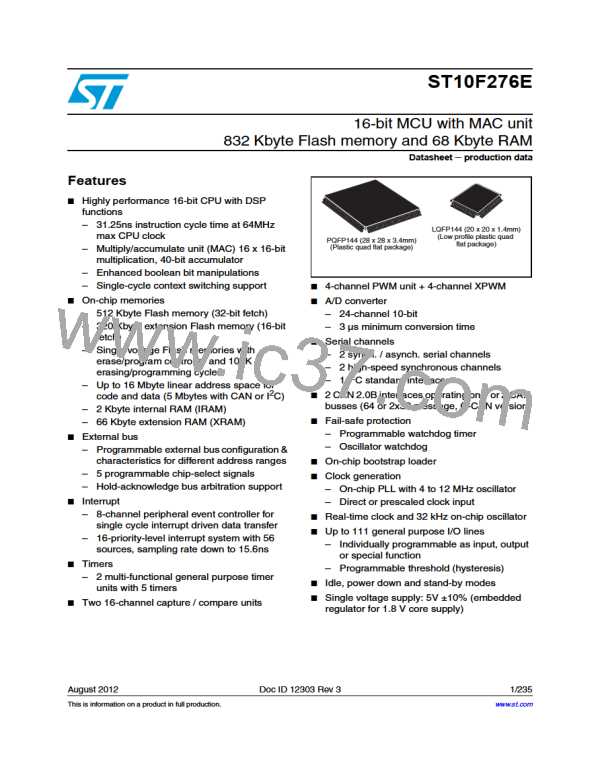ST10F276E
System reset
Short and long synchronous reset
Once the first maximum 16 TCL are elapsed (4+12TCL), the internal reset sequence starts.
It is 1024 TCL cycles long: at the end of it, and after other 8TCL the level of RSTIN is
sampled (after the filter, see RSTF in the drawings): if it is already at high level, only Short
Reset is flagged (refer to Chapter 19: System reset for details on reset flags); if it is
recognized still low, the Long reset is flagged as well. The major difference between Long
and Short reset is that during the Long reset, also P0(15:13) become transparent, so it is
possible to change the clock options.
Warning: In case of a short pulse on RSTIN pin, and when Bidirectional
reset is enabled, the RSTIN pin is held low by the internal
circuitry. At the end of the 1024 TCL cycles, the RTSIN pin is
released, but due to the presence of the input analog filter the
internal input reset signal (RSTF in the drawings) is released
later (from 50 to 500ns). This delay is in parallel with the
additional 8 TCL, at the end of which the internal input reset
line (RSTF) is sampled, to decide if the reset event is Short or
Long. In particular:
●
●
If 8 TCL > 500ns (fCPU < 8 MHz), the reset event is always recognized as Short
If 8 TCL < 500ns (fCPU > 8 MHz), the reset event could be recognized either as Short or
Long, depending on the real filter delay (between 50 and 500ns) and the CPU
frequency (RSTF sampled High means Short reset, RSTF sampled Low means Long
reset). Note that in case a Long Reset is recognized, once the 8 TCL are elapsed, the
P0(15:13) pins becomes transparent, so the system clock can be re-configured. The
port returns not transparent 3-4TCL after the internal RSTF signal becomes high.
The same behavior just described, occurs also when unidirectional reset is selected and
RSTIN pin is held low till the end of the internal sequence (exactly 1024TCL + max 16 TCL)
and released exactly at that time.
Note:
When running with CPU frequency lower than 40 MHz, the minimum valid reset pulse to be
recognized by the CPU (4 TCL) could be longer than the minimum analog filter delay (50ns);
so it might happen that a short reset pulse is not filtered by the analog input filter, but on the
other hand it is not long enough to trigger a CPU reset (shorter than 4 TCL): this would
generate a Flash reset but not a system reset. In this condition, the Flash answers always
with FFFFh, which leads to an illegal opcode and consequently a trap event is generated.
Exit from synchronous reset state
The reset sequence is extended until RSTIN level becomes high. Besides, it is internally
prolonged by the Flash initialization when EA = 1 (internal memory selected). Then, the
code execution restarts. The system configuration is latched from Port0, and ALE, RD and
WR/WRL pins are driven to their inactive level. The ST10F276E starts program execution
from memory location 00'0000h in code segment 0. This starting location will typically point
to the general initialization routine. Timing of synchronous reset sequence are summarized
in figures 28 and 29 where a Short Reset event is shown, with particular highlighting on the
fact that it can degenerate into Long Reset: the two figures show the behavior when booting
from internal or external memory respectively. Figures 30 and 31 report the timing of a
typical synchronous Long Reset, again when booting from internal or external memory.
Doc ID 12303 Rev 3
113/235

 STMICROELECTRONICS [ ST ]
STMICROELECTRONICS [ ST ]